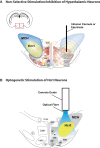Optogenetic deconstruction of sleep-wake circuitry in the brain
- PMID: 20126433
- PMCID: PMC2814554
- DOI: 10.3389/neuro.02.031.2009
Optogenetic deconstruction of sleep-wake circuitry in the brain
Abstract
How does the brain regulate the sleep-wake cycle? What are the temporal codes of sleep and wake-promoting neural circuits? How do these circuits interact with each other across the light/dark cycle? Over the past few decades, many studies from a variety of disciplines have made substantial progress in answering these fundamental questions. For example, neurobiologists have identified multiple, redundant wake-promoting circuits in the brainstem, hypothalamus, and basal forebrain. Sleep-promoting circuits have been found in the preoptic area and hypothalamus. One of the greatest challenges in recent years has been to selectively record and manipulate these sleep-wake centers in vivo with high spatial and temporal resolution. Recent developments in microbial opsin-based neuromodulation tools, collectively referred to as "optogenetics," have provided a novel method to demonstrate causal links between neural activity and specific behaviors. Here, we propose to use optogenetics as a fundamental tool to probe the necessity, sufficiency, and connectivity of defined neural circuits in the regulation of sleep and wakefulness.
Keywords: hypocretins/orexins; hypothalamus; optogenetics; sleep; wakefulness.
Figures

References
-
- Alam M. N., McGinty D., Szymusiak R. (1995). Neuronal discharge of preoptic/anterior hypothalamic thermosensitive neurons: relation to NREM sleep. Am. J. Physiol. 269, R1240–R1249 - PubMed
Grants and funding
LinkOut - more resources
Full Text Sources
Miscellaneous

